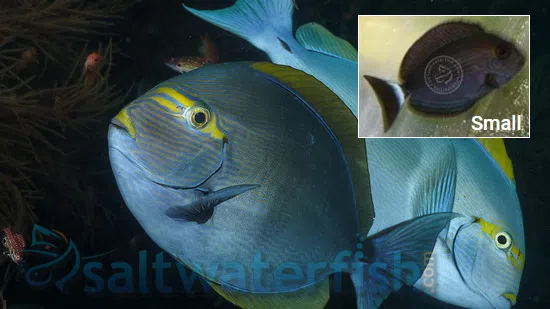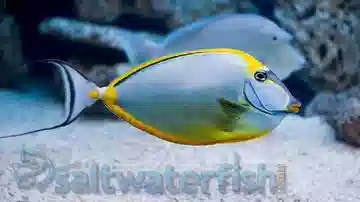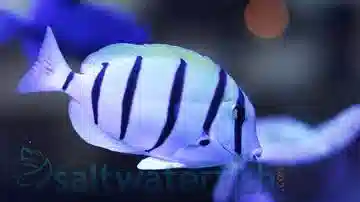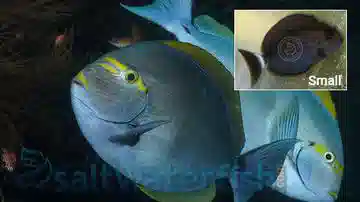Mata Tang
Acanthurus mata
(1 Reviews)

Mata Tang
Acanthurus mata
(1 Reviews)
{{ item.name }}
Size: {{ item.extra_field_3 }}
${{ getFormattedPrice(item.saleprice) }} ${{ getFormattedPrice(item.price) }}
To join the waiting list, click here
Free Shipping
With
$199.00
or more in Marine Life.
More details...
Mata Tang Care Facts
| Care Level: | Easy |
|---|---|
| Temperament: | Peaceful |
| Diet: | Omnivore |
| Reef Safe: | Yes |
| Minimum Tank Size: | 200 gallons |
| Max Size: | 20 inches |
Mata Tang (Acanthurus mata) Care Guide
The Mata Tang, scientifically known as Acanthurus mata, is a captivating and distinctive addition to saltwater marine aquariums. This care guide provides essential information for keeping the Mata Tang in your aquarium. We'll discuss their natural habitat, reef compatibility, size, lifespan, diet in captivity, aquaculture availability, compatibility with other marine species, sexual dimorphism, juvenile to adult coloration changes, temperament, detailed tank requirements, and specific water conditions. Additionally, we'll explore common names by which this species is known and suggest five compatible tank mates. You'll also learn why acquiring the Mata Tang from Saltwaterfish.com is prudent for marine enthusiasts.
The Mata Tang's Habitat
The Mata Tang is commonly found in the Indo-Pacific region, particularly around coral reefs and lagoons. Replicating its natural habitat in your aquarium is crucial to its well-being.
Is the Mata Tang Reef Safe?
Mata Tangs are generally considered reef safe. They tend to be peaceful towards corals and invertebrates, making them a suitable addition to reef aquariums. However, they may graze on algae, which could impact the growth of desirable coralline algae. Ensuring an ample supply of macroalgae for them to graze on can help prevent overgrazing of live corals.
Size and Lifespan of the Mata Tang
Mata Tangs can grow to 20 inches (50 cm) in a well-maintained aquarium. They can live for up to 10 to 15 years with proper care, making them a long-term commitment for marine enthusiasts.
The Mata Tang's Diet in Captivity
Mata Tangs are primarily herbivorous in captivity, and their diet should consist of marine algae and plant material. You can provide them with high-quality marine flakes, pellets, and frozen herbivore foods. Regularly offering marine algae sheets or live macroalgae is essential to replicate their natural diet.
Aquaculture and Availability of the Mata Tang
Mata Tangs are not commonly available through aquaculture. Most specimens are collected from the wild. When acquiring Mata Tangs, choosing a reputable supplier like Saltwaterfish.com is essential to ensure the fish is responsibly collected and properly acclimated to aquarium life.
Compatibility of the Mata Tang with Other Fish and Invertebrates:
Mata Tangs are generally peaceful and can coexist with various marine fish and invertebrates. However, it's essential to provide a sufficiently large tank with hiding spots and visual barriers to reduce the likelihood of territorial conflicts with other fish.
Sexual Dimorphism of the Mata Tang
Mata Tangs do not exhibit significant sexual dimorphism. Both males and females share similar physical characteristics and coloration.
Juvenile to Adult Coloration Changes in the Mata Tang
Juvenile Mata Tangs typically display a striking black-and-white coloration, which becomes more subdued as they mature into adults. The distinctive patterns and colors of juveniles make them particularly appealing to aquarists.
Temperament and Personality of the Mata Tang
Mata Tangs are known for their peaceful temperament. They get along well with other fish species in a community aquarium setting. However, like many tangs, they may display territorial behavior, so providing plenty of swimming space and hiding spots is advisable.
Tank Requirements for the Mata Tang
To ensure the well-being of your Mata Tang, it's essential to provide a tank of at least 200 gallons (approximately 760 liters). These active swimmers require sufficient space to thrive. Maintaining stable water conditions is crucial, including a pH level of 8.1 to 8.4, a salinity level of 1.020-1.025, and a temperature range of 74-82°F (23-28°C). Adequate water flow, a protein skimmer, and regular water changes are essential to maintain optimal water quality.
Tank Mates That Are Compatible with the Mata Tang
When selecting tank mates for your Mata Tang, consider the following five species:
- Flame Angelfish (Centropyge loriculus)
- Blue-green Chromis (Chromis viridis)
- Orchid Dottyback (Pseudochromis fridmani)
- Firefish Goby (Nemateleotris magnifica)
- Royal Gramma (Gramma loreto)
Why Choose Mata Tang from Saltwaterfish.com:
Obtaining a Mata Tang from reputable suppliers like Saltwaterfish.com guarantees the quality and health of your fish. Responsible collection practices and proper acclimation make Saltwaterfish.com a preferred choice for marine enthusiasts.
In conclusion, the Mata Tang is a visually striking and peaceful addition to your marine aquarium. By adhering to proper tank size, diet, and tank mate compatibility, you can enjoy the unique appearance of this species while maintaining a balanced and thriving aquatic environment.
Very cool fish and has awesome color when it lightens up
Reviewed by: Devin Short on Aug. 4, 2020















